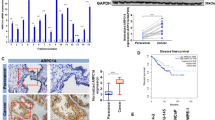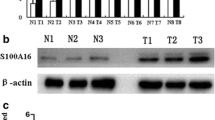Abstract
Background: Prostate cancer (PCa) is one of the most common cancers in men worldwide. Actin-related protein 2/3 complex subunit 5 (ARPC5) has been validated as a critical regulator in several kinds of human tumors. However, whether ARPC5 is implicated in PCa progression remains largely unknown. Methods: PCa specimens and PCa cell lines were obtained for detecting gene expressions using western blot and quantitative reverse transcriptase PCR (qRT-PCR). PCa cells transfected with ARPC5 shRNA or a disintegrin and metalloprotease 17 (ADAM17) overexpressed plasmids were harvested for assessing cell proliferation, migration and invasion by using cell counting kit-8 (CCK-8), colony formation and transwell assays, respectively. The interaction relationship between molecules was testified with chromatin immunoprecipitation and luciferase reporter assay. Xenograft mice model was conducted for confirming the role of ARPC5/ADAM17 axis in vivo. Results: Upregulated ARPC5 was observed in PCa tissues and cells, as well as forecasted poor prognosis of PCa patients. Depletion of ARPC5 inhibited PCa cell proliferation, migration and invasion. Krüppel-like factor 4 (KLF4) was identified to be a transcriptional activator of ARPC5 via binding with its promoter region. Furthermore, ADAM17 served as a downstream effector of ARPC5. ADAM17 overexpression overturned ARPC5 knockdown-induced repressive impacts on PCa progression in vitro and in vivo. Conclusion: Collectively, ARPC5 was activated by KLF4 and upregulated ADAM17 to promote PCa progression, which might act as a promising therapeutic target and prognostic biomarker for PCa.







Similar content being viewed by others
Data Availability
All data generated or analyzed during this study are included in this published article.
Abbreviations
- Arp2/3 complex:
-
actin-related protein 2/3 complex
- ARPC5:
-
actin-related protein 2/3 complex subunit 5
- KLF4:
-
krüppel-like factor 4
- ADAM:
-
a disintegrin and metalloprotease
- PCa:
-
prostate cancer
- qRT-PCR:
-
quantitative reverse transcriptase PCR
- CCK-8:
-
cell counting kit-8
- KMT2D:
-
histone lysine methyltransferase 2D
- MMP-2:
-
matrix metalloproteinase-2
- MMP-9:
-
matrix metalloproteinase-9
- LASP1:
-
LIM and SH3 protein 1
- YAP:
-
Yes-associated protein 1
References
Gandaglia G, Leni R, Bray F, Fleshner N, Freedland SJ, Kibel A et al (2021) Epidemiology and Prevention of prostate Cancer. Eur Urol Oncol 4(6):877–892
Kvizova J, Pavlickova V, Kmonickova E, Ruml T, Rimpelova S (2021) Quo Vadis Advanced prostate Cancer Therapy? Novel treatment perspectives and possible future directions.Molecules. ; 26(8)
Swami U, McFarland TR, Nussenzveig R, Agarwal N (2020) Advanced prostate Cancer: treatment advances and future directions. Trends Cancer 6(8):702–715
Schaeffer E, Srinivas S, Antonarakis ES, Armstrong AJ, Bekelman JE, Cheng H et al (2021) NCCN Guidelines Insights: prostate Cancer, Version 1.2021. J Natl Compr Canc Netw 19(2):134–143
Abella JV, Galloni C, Pernier J, Barry DJ, Kjaer S, Carlier MF et al (2016) Isoform diversity in the Arp2/3 complex determines actin filament dynamics. Nat Cell Biol 18(1):76–86
Rana PS, Alkrekshi A, Wang W, Markovic V, Sossey-Alaoui K (2021) The role of WAVE2 Signaling in Cancer.Biomedicines. ; 9(9)
Mughees M, Bano F, Wajid S (2021) Mechanism of WASP and WAVE family proteins in the progression of prostate cancer. Protoplasma 258(4):683–693
Huang S, Li D, Zhuang L, Sun L, Wu J (2021) Identification of Arp2/3 complex subunits as prognostic biomarkers for Hepatocellular Carcinoma. Front Mol Biosci 8:690151
Xiong T, Luo Z (2018) The expression of actin-related protein 2/3 Complex Subunit 5 (ARPC5) expression in multiple myeloma and its prognostic significance. Med Sci Monit 24:6340–6348
Kinoshita T, Nohata N, Watanabe-Takano H, Yoshino H, Hidaka H, Fujimura L et al (2012) Actin-related protein 2/3 complex subunit 5 (ARPC5) contributes to cell migration and invasion and is directly regulated by tumor-suppressive microRNA-133a in head and neck squamous cell carcinoma. Int J Oncol 40(6):1770–1778
Liu C, Liu R, Zhang D, Deng Q, Liu B, Chao HP et al (2017) MicroRNA-141 suppresses prostate cancer stem cells and metastasis by targeting a cohort of pro-metastasis genes. Nat Commun 8:14270
Wang G, Zhao D, Spring DJ, DePinho RA (2018) Genetics and biology of prostate cancer. Genes Dev 32(17–18):1105–1140
Rebello RJ, Oing C, Knudsen KE, Loeb S, Johnson DC, Reiter RE et al (2021) Prostate cancer. Nat Rev Dis Primers 7(1):9
Molinie N, Gautreau A (2018) The Arp2/3 Regulatory System and its Deregulation in Cancer. Physiol Rev 98(1):215–238
Yan P, Liu J, Zhou R, Lin C, Wu K, Yang S et al (2020) LASP1 interacts with N-WASP to activate the Arp2/3 complex and facilitate colorectal cancer metastasis by increasing tumour budding and worsening the pattern of invasion. Oncogene 39(35):5743–5755
Zhao K, Wang D, Zhao X, Wang C, Gao Y, Liu K et al (2020) WDR63 inhibits Arp2/3-dependent actin polymerization and mediates the function of p53 in suppressing metastasis. EMBO Rep 21(4):e49269
Lui JW, Moore SPG, Huang L, Ogomori K, Li Y, Lang D (2022) YAP facilitates melanoma migration through regulation of actin-related protein 2/3 complex subunit 5 (ARPC5). Pigment Cell Melanoma Res 35(1):52–65
Moriya Y, Nohata N, Kinoshita T, Mutallip M, Okamoto T, Yoshida S et al (2012) Tumor suppressive microRNA-133a regulates novel molecular networks in lung squamous cell carcinoma. J Hum Genet 57(1):38–45
Ghaleb AM, Yang VW (2017) Kruppel-like factor 4 (KLF4): what we currently know. Gene 611:27–37
Taracha-Wisniewska A, Kotarba G, Dworkin S, Wilanowski T (2020) Recent discoveries on the involvement of Kruppel-Like factor 4 in the most common Cancer types.Int J Mol Sci. ; 21(22)
Lv S, Ji L, Chen B, Liu S, Lei C, Liu X et al (2018) Histone methyltransferase KMT2D sustains prostate carcinogenesis and metastasis via epigenetically activating LIFR and KLF4. Oncogene 37(10):1354–1368
Feng F, Liu H, Chen A, Xia Q, Zhao Y, Jin X et al (2019) Mir-148-3p and mir-152-3p synergistically regulate prostate cancer progression via repressing KLF4. J Cell Biochem 120(10):17228–17239
Barakat DJ, Suresh R, Barberi T, Pienta KJ, Simons BW, Friedman AD (2018) Absence of myeloid Klf4 reduces prostate cancer growth with pro-atherosclerotic activation of tumor myeloid cells and infiltration of CD8 T cells. PLoS ONE 13(1):e0191188
Zunke F, Rose-John S (2017) The shedding protease ADAM17: physiology and pathophysiology. Biochim Biophys Acta Mol Cell Res 1864(11 Pt B):2059–2070
Calligaris M, Cuffaro D, Bonelli S, Spano DP, Rossello A, Nuti E et al (2021) Strategies to Target ADAM17 in Disease: from its Discovery to the iRhom Revolution.Molecules. ; 26(4)
Grotzinger J, Lorenzen I, Dusterhoft S (2017) Molecular insights into the multilayered regulation of ADAM17: the role of the extracellular region. Biochim Biophys Acta Mol Cell Res 1864(11 Pt B):2088–2095
Rossello A, Nuti E, Ferrini S, Fabbi M (2016) Targeting ADAM17 sheddase activity in Cancer. Curr Drug Targets 17(16):1908–1927
Cai C, Zhi Y, Wang K, Zhang P, Ji Z, Xie C et al (2019) CircHIPK3 overexpression accelerates the proliferation and invasion of prostate cancer cells through regulating miRNA-338-3p. Onco Targets Ther 12:3363–3372
Revandkar A, Perciato ML, Toso A, Alajati A, Chen J, Gerber H et al (2016) Inhibition of notch pathway arrests PTEN-deficient advanced prostate cancer by triggering p27-driven cellular senescence. Nat Commun 7:13719
Lin P, Sun X, Feng T, Zou H, Jiang Y, Liu Z et al (2012) ADAM17 regulates prostate cancer cell proliferation through mediating cell cycle progression by EGFR/PI3K/AKT pathway. Mol Cell Biochem 359(1–2):235–243
Xiao LJ, Lin P, Lin F, Liu X, Qin W, Zou HF et al (2012) ADAM17 targets MMP-2 and MMP-9 via EGFR-MEK-ERK pathway activation to promote prostate cancer cell invasion. Int J Oncol 40(5):1714–1724
Kumar V, Vashishta M, Kong L, Lu JJ, Wu X, Dwarakanath BS et al (2022) Carbon Ion Irradiation Downregulates Notch Signaling in Glioma Cell Lines, Impacting Cell Migration and Spheroid formation. Cells 11:21
Huang L, Chen J, Quan J, Xiang D (2021) Rosmarinic acid inhibits proliferation and migration, promotes apoptosis and enhances cisplatin sensitivity of melanoma cells through inhibiting ADAM17/EGFR/AKT/GSK3beta axis. Bioengineered 12(1):3065–3076
Hong Y, Chen X, Liang Z, Xu Z, Li Y, Pan Y (2020) MiR-338-3p inhibits cell migration and invasion in human hypopharyngeal cancer via downregulation of ADAM17. Anticancer Drugs 31(9):925–931
Giri A, Bajpai S, Trenton N, Jayatilaka H, Longmore GD, Wirtz D (2013) The Arp2/3 complex mediates multigeneration dendritic protrusions for efficient 3-dimensional cancer cell migration. FASEB J 27(10):4089–4099
Wei Z, Wang R, Yin X, Zhang L, Lei Y, Zhang Y et al (2022) PRR11 induces filopodia formation and promotes cell motility via recruiting ARP2/3 complex in non-small cell lung cancer cells. Genes Dis 9(1):230–244
Takayama KI, Suzuki T, Fujimura T, Takahashi S, Inoue S (2018) COBLL1 modulates cell morphology and facilitates androgen receptor genomic binding in advanced prostate cancer. Proc Natl Acad Sci U S A 115(19):4975–4980
Plesingerova H, Librova Z, Plevova K, Libra A, Tichy B, Skuhrova Francova H et al (2017) COBLL1, LPL and ZAP70 expression defines prognostic subgroups of chronic lymphocytic leukemia patients with high accuracy and correlates with IGHV mutational status. Leuk Lymphoma 58(1):70–79
Plesingerova H, Janovska P, Mishra A, Smyckova L, Poppova L, Libra A et al (2018) Expression of COBLL1 encoding novel ROR1 binding partner is robust predictor of survival in chronic lymphocytic leukemia. Haematologica 103(2):313–324
Han SH, Kim SH, Kim HJ, Lee Y, Choi SY, Park G et al (2017) Cobll1 is linked to drug resistance and blastic transformation in chronic myeloid leukemia. Leukemia 31(7):1532–1539
Acknowledgements
We would like to give our sincere gratitude to the reviewers for their constructive comments.
Funding
This work was supported by Zhuzhou Science and Technology Plan Project (2021-007).
Author information
Authors and Affiliations
Contributions
GenYi Qu: Conceptualization, Methodology, Supervision, Writing- Original draft preparation, Investigation, Writing- Reviewing and Editing
YuLong Zhang: Software
HongTao Duan: Visualization
Cheng Tang: Validation
Guang Yang: Data curation
Dan Chen: Data curation
Yong Xu: Conceptualization, Supervision, Writing- Original draft preparation, Writing- Reviewing and Editing.
Corresponding author
Ethics declarations
Ethics approval and consent to participate
In this study, a total of 42 pairs of PCa tissues and its matched normal adjacent tissues were gathered from PCa patients who received surgical resection at ZhuZhou central hospital from 2019 to 2022, with informed consent from all patients. The patients enrolled had not received preoperative chemotherapy or radiotherapy. The tissues were preserved in liquid nitrogen for subsequent experiments. This present research was approved by the Ethics Committee of ZhuZhou central hospital. The experimental protocols were approved by the Ethical Commission of the Animal Care in ZhuZhou central hospital.
Consent for publication
The informed consent was obtained from all participants.
Competing interests
The authors declare no competing interests.
Additional information
Publisher’s Note
Springer Nature remains neutral with regard to jurisdictional claims in published maps and institutional affiliations.
Electronic supplementary material
Below is the link to the electronic supplementary material.
Supplementary Material 1
The mRNA expressions of ADAMs (ADAM9, ADAM10, ADAM12, ADAM15, ADAM17) were detected after silencing ARPC5 in PC3 and DU145 cells. All experiments were repeated three times. And data are presented as the mean ? standard deviation. *p < 0.05, **p < 0.01, ***p < 0.001.
Rights and permissions
Springer Nature or its licensor (e.g. a society or other partner) holds exclusive rights to this article under a publishing agreement with the author(s) or other rightsholder(s); author self-archiving of the accepted manuscript version of this article is solely governed by the terms of such publishing agreement and applicable law.
About this article
Cite this article
Qu, G., Zhang, Y., Duan, H. et al. ARPC5 is transcriptionally activated by KLF4, and promotes cell migration and invasion in prostate cancer via up-regulating ADAM17. Apoptosis 28, 783–795 (2023). https://doi.org/10.1007/s10495-023-01827-3
Accepted:
Published:
Issue Date:
DOI: https://doi.org/10.1007/s10495-023-01827-3




